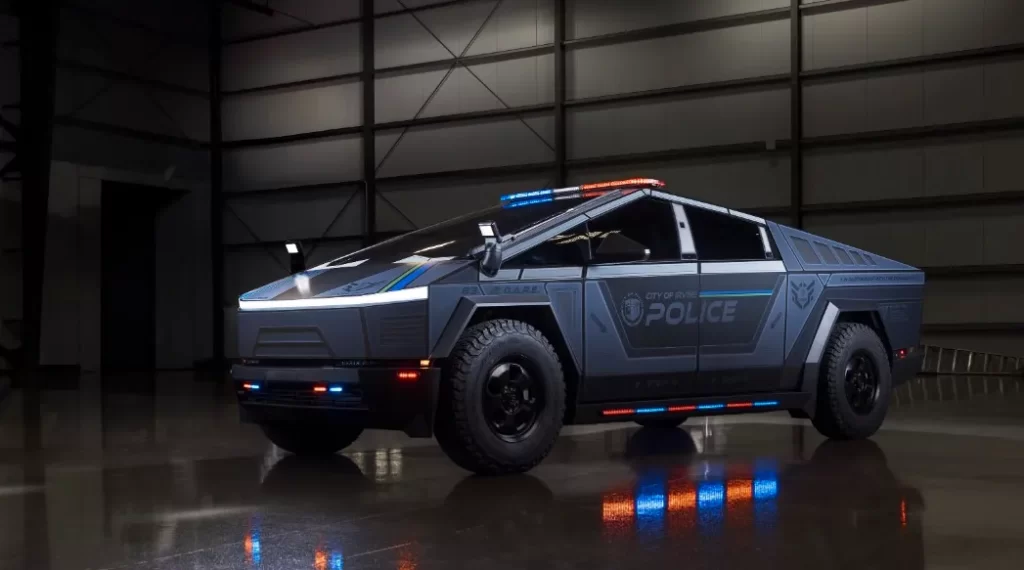In a groundbreaking move, the Irvine Police Department in Southern California has made headlines by purchasing the nation’s first Tesla Cybertruck for police use. With a price tag of $153,175.03, including the installation of necessary emergency equipment, this unique vehicle will serve primarily to enhance community outreach efforts, particularly in anti-drug education initiatives.
A New Approach to D.A.R.E.
The Cybertruck will be utilized for the Drug Abuse Resistance Education (D.A.R.E.) program, aimed at engaging students and raising awareness about the dangers of drug abuse. According to the Irvine Police, this flashy vehicle is intended to capture the attention of young people, making the program more relatable and impactful. “For over three decades, our DARE officers have driven attention-grabbing and one-of-a-kind vehicles that never fail to turn heads and excite students,” the department stated in a post on Facebook.
The unveiling of the Cybertruck was accompanied by a visually striking promotional video, showcasing the vehicle driving through the night with flashing lights and dramatic music. This kind of theatrical presentation aims to generate excitement around the D.A.R.E. program, reminding students and parents alike of its importance in today’s society.
Economic Considerations
While the price of the Cybertruck is significantly higher than that of traditional police vehicles, the department believes it will be a wise investment in the long run. A Ford Police Interceptor, commonly used by police departments, costs around $116,000 and typically has a lifespan of three to four years. In contrast, the Irvine Police expect the Cybertruck to remain operational for at least ten years, potentially saving costs on fuel and maintenance over its lifetime.
Sgt. Karie Davies, a spokesperson for the department, elaborated on these savings: “The Cybertruck is a replacement for another D.A.R.E. vehicle that has reached its shelf life. We expect to save money in the long run, including by not having to purchase gas for the Cybertruck.” This shift toward electric vehicles aligns with broader environmental goals and represents a forward-thinking approach to law enforcement.
A Unique Choice Amid Controversy
The decision to invest in the Cybertruck, however, hasn’t been without its challenges. Since its launch, the Tesla Cybertruck has faced a series of recalls—five in total—due to software and equipment issues. Moreover, its unconventional design has made it a frequent subject of jokes and memes online, especially concerning its vulnerability to sun exposure and other environmental factors.
Despite these concerns, the Irvine Police Department remains optimistic about the vehicle’s potential. They clarified that while the Cybertruck won’t serve as a traditional patrol car, it will be available for emergency responses and community assistance as needed. This flexibility highlights the department’s intention to leverage the Cybertruck’s unique features for various purposes, contributing to community safety beyond its primary function in the D.A.R.E. program.
Community Engagement and Future Prospects
Community engagement is a key component of the Irvine Police Department’s strategy. By using innovative methods to connect with the youth, they hope to foster trust and cooperation between law enforcement and the communities they serve. The D.A.R.E. program has been instrumental in this effort, and the addition of the Cybertruck is expected to breathe new life into the initiative.
As the police department moves forward with this unique investment, it opens up discussions about the role of modern technology in law enforcement. The Cybertruck not only represents a shift towards more sustainable and cost-effective policing but also serves as a symbol of innovation in community outreach.
The Broader Implications
The Irvine Police Department’s acquisition of the Cybertruck could set a precedent for other law enforcement agencies. As electric vehicles become increasingly viable options, police departments across the country may look to similar investments. The success of the Cybertruck in enhancing community outreach and its performance in various roles could influence future purchases.
Moreover, this move aligns with a growing trend in law enforcement to adopt technology that promotes transparency and engagement with the public. As agencies strive to improve community relations, innovative approaches such as this one may become more common.
Conclusion
The Irvine Police Department’s purchase of the Tesla Cybertruck marks a significant step in blending modern technology with traditional law enforcement practices. While its primary role will be to support the D.A.R.E. program, the potential for broader applications could redefine how police departments interact with their communities.
As they embrace this new chapter, the department not only aims to combat drug abuse among youth but also seeks to redefine the image of law enforcement through innovation and engagement. Whether or not the Cybertruck proves to be the game-changer they envision, its introduction is undoubtedly a fascinating development in the ongoing evolution of policing in America.
In the coming years, the effectiveness of this initiative will be closely watched—not just in Irvine but across the country—as communities and police departments alike navigate the future of law enforcement in an increasingly complex world.

